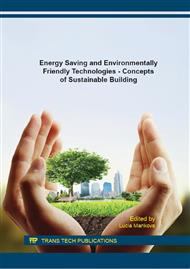[1]
HAM and mould growth analysis of a wooden wall; Fedorik F., Illikainen K., International Journal of Sustainable Built Environment (2013), pp.19-26.
DOI: 10.1016/j.ijsbe.2013.09.002
Google Scholar
[2]
Towards modelling of decay risk of wooden materials; Viitanen H., Toratti T., Makkonen L., Peuhkuri R., Ojanen T., Ruokolainen L., Räisänen J., European Journal of Wood and Wood Products 68, 3 (2010), pp.303-313.
DOI: 10.1007/s00107-010-0450-x
Google Scholar
[3]
BRESET - Remote Sensing Technology for Building Physics Research of Structures; Bečkovský, D., Vajkay, F., Trans Tech Publications, Switzerland (2014), pp.575-578.
DOI: 10.4028/www.scientific.net/amr.899.575
Google Scholar
[4]
Experimental data set for validation of heat, air and moisture transport models of building envelopes; Desta T. Z.; Langmans J., Roels S., Building and Environment 46 (2011), pp.1038-1046.
DOI: 10.1016/j.buildenv.2010.11.002
Google Scholar
[5]
The transition of the water steam through the composition of the diffusive closed circumferential wall of the wooden house with the proper and improper realization of vapor barrier; Uvizlová M., Bečkovská T, Advanced Materials Research Vol. 899 (2014).
DOI: 10.4028/www.scientific.net/amr.899.446
Google Scholar
[6]
Use of microwave radiation in building industry through application of wood element drying; Novotný, M.; Šuhajda, K.; Sobotka, J.; Gintar, J.; Šuhajdová, E.; Mátl, M., Wood research (3/2014), pp.389-400.
DOI: 10.4028/www.scientific.net/amr.1041.297
Google Scholar
[7]
ČSN EN ISO 12572 Hygrothermal performance of building materials and products – Determination of water vapour transmission properties, (July 2002), Praha: Český normalizační institute, (2002).
Google Scholar
[8]
Moisture transport through perforated vapour retarder; Slanina, P., Šilarová, Š., Building and Environment 44 (2009), pp.1617-1626.
DOI: 10.1016/j.buildenv.2008.10.006
Google Scholar
[9]
Information on http: /www. isover. cz.
Google Scholar
[10]
Information on https: /www. dek. cz.
Google Scholar


